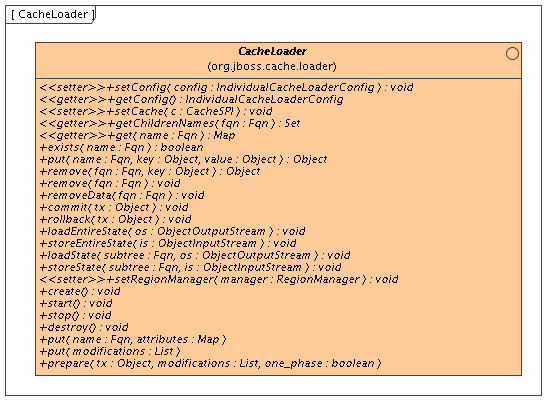이 콘텐츠는 선택한 언어로 제공되지 않습니다.
Chapter 9. Cache Loaders
JBoss Cache can use a
CacheLoader to back up the in-memory cache to a back end datastore. If JBoss Cache is configured with a cache loader, then the following features are provided:
- Whenever a cache element is accessed, and that element is not in the cache (e.g. due to eviction or due to server restart), then the cache loader transparently loads the element into the cache if found in the back end store.
- Whenever an element is modified, added or removed, then that modification is persisted in the back end store via the cache loader. If transactions are used, all modifications created within a transaction are persisted. To this end, the
CacheLoadertakes part in the two phase commit protocol run by the transaction manager, although it does not do so explicitly.
9.1. The CacheLoader Interface and Lifecycle
링크 복사링크가 클립보드에 복사되었습니다!
Figure 9.1. The CacheLoader interface
The interaction between JBoss Cache and a
CacheLoader implementation is as follows. When CacheLoaderConfiguration (see below) is non-null, an instance of each configured CacheLoader is created when the cache is created, and started when the cache is started.
CacheLoader.create() and CacheLoader.start() are called when the cache is started. Correspondingly, stop() and destroy() are called when the cache is stopped.
Next,
setConfig() and setCache() are called. The latter can be used to store a reference to the cache, the former is used to configure this instance of the CacheLoader . For example, here a database cache loader could establish a connection to the database.
The
CacheLoader interface has a set of methods that are called when no transactions are used: get() , put() , remove() and removeData() : they get/set/remove the value immediately. These methods are described as javadoc comments in the interface.
Then there are three methods that are used with transactions:
prepare() , commit() and rollback() . The prepare() method is called when a transaction is to be committed. It has a transaction object and a list of modifications as argument. The transaction object can be used as a key into a hashmap of transactions, where the values are the lists of modifications. Each modification list has a number of Modification elements, which represent the changes made to a cache for a given transaction. When prepare() returns successfully, then the cache loader must be able to commit (or rollback) the transaction successfully.
JBoss Cache takes care of calling prepare(), commit() and rollback() on the cache loaders at the right time.
The
commit() method tells the cache loader to commit the transaction, and the rollback() method tells the cache loader to discard the changes associated with that transaction.
See the javadocs on this interface for a detailed explanation on each method and the contract implementations would need to fulfill.
